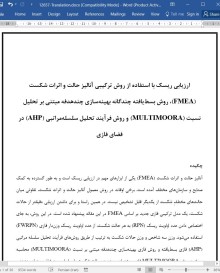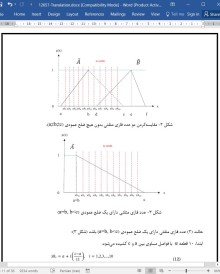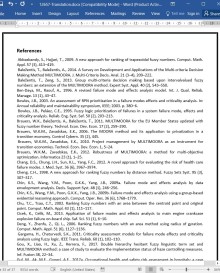
دانلود مقاله ارزیابی ریسک با استفاده از روش ترکیبی آنالیز حالت و اثرات شکست، روش بسط یافته چندگانه بهینه سازی چندهدفه مبتنی بر تحلیل نسبت و AHP در محیط فازی
چکیده
آنالیز حالت و اثرات شکست (FMEA) یکی از ابزارهای مهم در ارزیابی ریسک است و به طور گسترده به کمک صنایع و سازمانهای مختلف آمده است. برخی اوقات در روش معمول آنالیز حالت و اثرات شکست، تفاوتی میان حالتهای مختلفِ شکست از یکدیگر قابل تشخیص نیست. در همین راستا و برای داشتن ارزیابی دقیقتر از حالات شکست، یک مدل ترکیبی فازی جدید بر اساس FMEA در این مقاله پیشنهاد شده است. در این روش، به جای اختصاص دادن عدد اولویت ریسک (RPN) به هر حالت شکست، از عدد اولویت ریسک وزندار فازی (FWRPN) استفاده میشود. وزنِ سه شاخص و وزنِ حالات شکست به ترتیب از طریق روشهای فرآیند تحلیل سلسله مراتبی (AHP) فازی بسطیافته و روش فازی بهینهسازی چندهدفه مبتنی بر نسبت (MULTIMOORA) محاسبه میشود. روش MULTIMOORA فازی پیشنهادی، وزن هر حالت شکست را بر اساس سه شاخص زمان، هزینه و سود از طریق اصطلاحات فازی میسنجد. پس از آنکه عدد اولویت ریسک وزندار فازی برای هر حالت شکست بدست آمد، عملیات اصلاحی به منظور کاهش دادن و یا حذفکردن اثراتِ شکستهای شناسایی شده آغاز میگردد. سپس، عدد اولویت ریسک وزندار فازی اصلاحشده (CFWRPN) برای هر حالت شکست محاسبه میشود. در نهایت، میانگین اعداد اولویت ریسک وزندار فازی با میانگینِ اعداد اولویت ریسک وزندار فازی اصلاحشده مقایسه میشود تا میزان اثرگذاریِ عملیات اصلاحی از طریق روش رتبهبندی اعداد فازی محاسبه شود. به علاوه، روش پیشنهادی رتبهبندی عدد فازی، در هر دو روش تصمیمگیری چندمعیاره فازی استفاده میشود. در پایان، از کارخانه صنایع فولاد کرمان به عنوان مورد مطالعاتی جهت نشان دادن کاربردپذیری و مزایای روش ترکیبی فازی پیشنهادی استفاده شده است. از تحلیل حساسیت به منظور اعتبارسنجی نتایج بهره گرفته شد. یافتهها حاکی از آن است که میانگین اعداد اولویت ریسک وزندار فازی (AFWRPNs) در قیاس با میانگین اعداد اولویت ریسک وزندار فازی اصلاحشده (ACFWRPNs) به میزان 56% کاهش یافته است.
1-مقدمه
ارزیابی ریسک یک روش منطقی برای مشخصکردن ابعاد کیفی و کمی ریسکها است. همچنین ارزیابی ریسک به واکاوی پیامدهای بالقوه حوادث احتمالی بر افراد، مواد، محصولات، تجهیزات و محیط میپردازد. امروزه، بکارگیری روشهای ارزیابی ریسک در صنایع و سازمانهای مختلف رو به افزایش است. یکی از مهمترین روشها برای ارزیابی ریسک به روش تحلیل حالت و اثرات شکست (FMEA) معروف است. آنالیز حالت و اثرات شکست یک روش تحلیلی در ارزیابی ریسک است که تا جای ممکن تلاش میکند ریسکها را شناسایی و اولویتبندی کند. در واقع این روش به علل و اثرات مرتبط با هر ریسک نمرهای اختصاص دهد. روش تحلیل حالت و اثرات شکست، ابزاری نیرومند به منظور تعریفکردن، شناساییکردن و حذفکردن شکستها، مسائل، خطاها و... شناختهشده و/یا احتمالی از سیستم، طراحی، فرآیند و/یا خدمترسانی پیش از ارائه به مصرفکننده است.
ایالات متحده آمریکا برای اولین بار از تحلیل حالت و اثرات شکست در سال 1949 میلادی استفاده کرد. پس از آن به دلیل ظرفیت و موثربودن این روش، از آن در صنایع هوافضا و خودروسازی و کمی بعدتر در تولیدِ عام استفاده شد. هدف از انجام تحلیل حالت و اثرات شکست، بهبود بخشیدن به پایداری سیستم است. به منظور برآورده کردن این هدف، ابتدا باید از این روش برای شناسایی و اولویتبندی حالات شکست محتمل استفاده کرد تا منابع محدود به ضروریترین حالتها تخصیص یابد. در مرحله بعد، برخی اعمال پیشگیرانه و اصلاحی باید در نظر گرفته شود تا حالاتِ شکستِ شناسایی شده، حذف گردد یا اثرات آنها به حداقل برسد. امروزه بسیاری از مهندسین از روششناسی FMEA استفاده میکنند تا از سلامت و قابلیتاعتماد افراد، محصولات، مواد، تجهیزات و فرآیندها در حوزههای صنعتی مختلف اطمینان حاصل کنند.
6- نتیجهگیری و ملاحظاتی برای آینده
ارزیابی ریسک روشی است که به شکل منطقی به دنبال کمیسازی و کیفیسازی مقادیر ریسک بوده و در عینحال پیامدهای ریسک را نیز بررسی میکند. یکی از مهمترین ابزارهای ارزیابی ریسک، آنالیز حالت و اثرات شکست (FMEA) است که به طور گستردهای در صنایع و سازمانهای مختلف استفاده میشود. به منظور ارزیابی دقیقترِ حالات مختلف شکست، یک روش ترکیبی فازی جدید بر مبنای FMEA فازی، MULTIMOORA فازی بسطیافته و روش AHP فازی پیشنهاد شد. در روش پیشنهادی این مقاله، وزنِ هر یک از سه عامل ریسک و وزنِ هر حالت شکست به ترتیب با استفاده از روش فرآیند تحلیل سلسلهمراتبی (AHP) فازی بسطیافته و MULTIMOORA فازی محاسبه گردید. به بیان دیگر، وزنِ حالات مختلف شکست و وزنِ سه عامل ریسک فازی همزمان لحاظ شد. همین کار باعث افزایش دقت در محاسبهکردن عدد اولویت ریسک (RPN) و ارتقابخشی در میزانِ تاثیر FMEA شد. به جای استفاده از عدد اولویت ریسک برای هر حالت شکست، این روش از مزیتِ عدد اولویت ریسک وزندار فازی (FWRPN) بهره میبرد.
در این روش، وزنِ هر حالت شکست توسط روش MULTIMOORA فازی پیشنهادی بر اساس سه معیار زمان، هزینه و سود محاسبه شد. پس از محاسبهکردن FWRPN برای هر حالت شکست، اقدامات اصلاحی لازم به منظور کاهشدادن یا حذفکردن اثراتِ هر حالت شکست انجام شد. سپس عدد اولویت ریسک وزندار فازی اصلاحشده (CFWRPN) برای هر حالت شکست محاسبه شد. در نهایت، میانگین اعداد اولویت ریسک وزندار فازی (AFWRPNs) با میانگینِ اعداد اولویت ریسک وزندار فازی اصلاحی (ACFWRPNs) مقایسه شد تا میزان تاثیر اقدامات اصلاحی سنجیده شود. در این مقایسه از روش رتبهبندی اعداد فازی بهره گرفته شد. کارخانه صنایع فولاد کرمان به عنوان مورد مطالعاتی این مقاله انتخاب شد و روش ترکیبی فازی پیشنهادی در مورد آن به اجرا گذاشته شد. بر اساس نتایج بدست آمده، FWRPN برای حوادث کاری در کارخانه، زیاد (High) گزارش شد. بنابراین، اقدامات اصلاحی لازم انجام شد تا حوادث حرفهای در محیط کار کاهش یابد. پس از انجام اقدامات اصلاحی، میزان تاثیر اقدامات سنجیده شد. در همین راستا، از روش رتبهبندی اعداد فازی جدید برای مقایسه میانگین اعداد اولویت ریسک وزندار فازی (AFWRPNs) و میانگینِ اعداد اولویت ریسک وزندار فازی اصلاحی (ACFWRPNs) استفاده شد. در انتها، یک آنالیز حساسیت گرفته شد تا صحت نتایج بدست آمده اعتبارسنجی شود. یافتهها حاکی از آن بود که ACFWRPNs در قیاس با AFWRPNs به میزان 56% کاهش داشته است.
به عنوان موضوعی برای مطالعات آتی، پیشنهاد میشود که پایایی (reliability) روش پیشنهادی در دیگر مطالعات موردی، صنایع مختلف و کشورهای گوناگون به محک آزمون سپرده شود. به علاوه، مطالعات آتی ممکن است برای بسطدادن مدل پیشنهادی ما از طریق بکارگیری روشهای جدیدی حاصل از تصمیمگیری چندمعیاره موثر باشد. همچنین پیشنهاد ما این است که در روش تصمیمگیری چندمعیاره جدید، از راهحل نوینی جهت رتبهبندی اعداد فازی و مقایسه میان آنها استفاده شود.
Abstract
Failure mode and effects analysis (FMEA) is one of the most important risk assessment tools which has been extensively used in different industries and organizations. In the conventional FMEA, sometimes the difference between some failure modes cannot be distinguished. In order to evaluate various failure modes more precisely, a novel fuzzy hybrid model for FMEA is proposed in this paper. In this method, fuzzy weighted risk priority number (FWRPN) is considered instead of RPN for each failure. The weights of the three factors and the weights of failure modes are computed by extended fuzzy AHP and fuzzy MULTIMOORA methods, respectively. The proposed fuzzy MULTIMOORA method calculates the weight of each failure based on three criteria of time, cost, and profit through fuzzy linguistic terms. After calculating FWRPN for each failure, corrective actions are performed for eliminating the identified failures or decreasing the effects of them. Then, corrected fuzzy weighted risk priority number (CFWRPN) is computed for each failure. Finally, the average of FWRPNs (AFWRPNs) with the average of CFWRPNs (ACFWRPNs) are compared to evaluate the effectiveness of corrective actions by a novel ranking fuzzy numbers method. In addition, the proposed ranking fuzzy number method is also used in both previously mentioned fuzzy multi-criteria decision making (MCDM) methods. Eventually, Kerman Steel Industries Factory is considered as a case study to demonstrate the applicability and benefits of the proposed fuzzy hybrid method. A sensitivity analysis is performed to validate the obtained results. Findings show that AFWRPNs decreased by 56% compared to ACFWRPNs.
1. Introduction
Risk evaluation is a logical method to determine quantitative and qualitative value of risks and investigate potential consequences of probable accidents on people, materials, products, equipment, and environment. Nowadays, application of risk evaluation methods in different industries and organizations is growing. One of the most important of these methods is failure mode and effects analysis (FMEA). FMEA is an analytical method in risk assessment which tries as much as possible to identify and prioritize potential risks in areas where risk assessment is done and also to determine and score causes and effects which are associated with them. In other words, it is a strong and helpful tool which can be employed to define, identify, and eliminate known and/or potential failures, problems, errors, and so on from the system, design, process, and/or service before they reach customers (Stamatis, 2003; Kutlu and Ekmekçioğlu, 2012; Cicek and Celik, 2013).
The United States Army performed and developed the FMEA technique for the first time in 1949. Afterwards, in the 1970s, because of its capability and effectiveness, it was first used in aerospace and automotive industry, then in general manufacturing (Scipioni et al., 2002). The purpose of the FMEA is to improve the system reliability. To achieve this goal, first it should be employed to identify and prioritize potential failure modes in order to assign the limited resources to the most essential ones of them. Then, some necessary preventive and corrective actions should be considered to eliminate the identified failure modes or to decrease the effects of them (Liu et al., 2014a). Nowadays, many engineers widely apply the FMEA methodology to ensure the safety and reliability of people, products, materials, equipment, and processes in various industries (Chang et al., 2012; Kutlu and Ekmekçioğlu, 2012; Song et al., 2014; Vinodh et al., 2012).
6. Conclusion and future remarks
Risk evaluation is defined as a method which is logically used for determining quantitative and qualitative risks value and investigating potential consequences. One of the most important risk assessment tools, FMEA, has been extensively used in different industries and organizations. In order to evaluate various failure modes more precisely the suggested novel fuzzy hybrid method based on fuzzy FMEA, extended fuzzy MULTIMOORA, and fuzzy AHP methods were proposed in this paper in which the weights of the three risk factors and the weight of each failure mode were calculated by the extended fuzzy AHP and fuzzy MULTIMOORA methods, respectively. In other words, in the proposed method, the weights of the three risk factors and the weights of each failure mode were considered simultaneously. This resulted in more precise calculations of RPNs as well as the improved the effectiveness of the FMEA method. Instead of utilizing RPN for each failure, this method benefited from the fuzzy weighted risk priority number (FWRPN).
In this method, the weight of each failure mode was computed by the proposed fuzzy MULTIMOORA method on the basis of three criteria of time, cost, and profit. After calculating FWRPN for each failure, proper following corrective actions were conducted to either eliminate the identified failures or decrease their impacts and for each failure the corrected fuzzy weighted risk priority number (CFWRPN) was computed. Finally, the average of FWRPNs (AFWRPNs) was compared with the average of CFWRPNs (ACFWRPNs) to evaluate the effectiveness of corrective actions by the use of the novel ranking fuzzy numbers method. As a case study, the risk of occupational accidents in Kerman Steel Industries Factory was evaluated by the novel fuzzy hybrid method. According to the obtained results, the FWRPNs of occupational accidents in the factory were high. Therefore, suitable corrective actions were performed in order to reduce the accidents. After implementing the corrective actions, the effectiveness of these actions was evaluated. For this purpose, the novel fuzzy number ranking was applied to compare the average of FWRPNs (AFWRPNs) with the average of CFWRPNs (ACFWRPNs). Eventually, a sensitivity analysis was performed to validate the obtained results. Findings showed that AFWRPNs decreased by 56% compared to ACFWRPNs.
As a future remark, it is suggested to validate the reliability of the proposed method in other case studies, different industries, and various countries. Moreover, further studies might be useful to extend the proposed model by the applications of the new MCDM methods. Using a new method for ranking fuzzy numbers to compare the fuzzy numbers in the proposed MCDM methods is another suggestion for future research.
چکیده
1-مقدمه
2- نظریه مجموعه فازی و روشی جدید برای رتبهبندی اعداد فازی
2-1 نظریه مجموعه فازی
2-2 روشی جدید برای رتبهبندی اعداد فازی
2-2-1 یک مثال قیاسی
3- روشهای تصمیمگیری چندمعیاره فازی جدید پیشنهادی
3-1 روش فرآیند تحلیل سلسلهمراتبی فازی جدید
3-2 روش چندگانه بهینهسازی چندهدفه مبتنی بر تحلیل نسبت (MULTIMOORA) فازی بسطیافته
4- روش ترکیبی پیشنهادی که استوار بر آنالیز حالت و اثرات شکست (FMEA) فازی و روش چندگانه بهینهسازی چندهدفه مبتنی بر تحلیل نسبت (MULTIMOORA) فازی بسطیافته و فرآیند تحلیل سلسلهمراتبی (AHP) فازی است.
5- کاربرد و نتایج
6- نتیجهگیری و ملاحظاتی برای آینده
منابع
ABSTRACT
1. Introduction
2. Fuzzy set theory and a novel method for ranking fuzzy numbers
2.1. Fuzzy set theory
2.2. A novel method for ranking fuzzy numbers
2.2.1. Comparative example
3. The proposed novel fuzzy multi-criteria decision making (MCDM) methods
3.1. The new fuzzy AHP method
3.2. The extended fuzzy MULTIMOORA method
4. The proposed hybrid method based on fuzzy FMEA and extended fuzzy MULTIMOORA and fuzzy AHP methods
5. Application and results
6. Conclusion and future remarks
References
- ترجمه فارسی مقاله با فرمت ورد (word) با قابلیت ویرایش، بدون آرم سایت ای ترجمه
- ترجمه فارسی مقاله با فرمت pdf، بدون آرم سایت ای ترجمه



